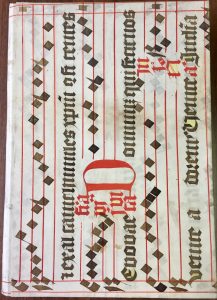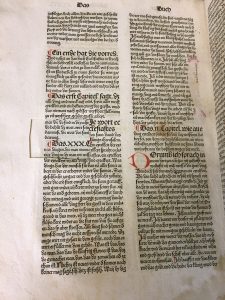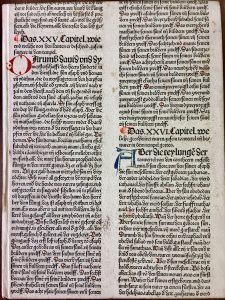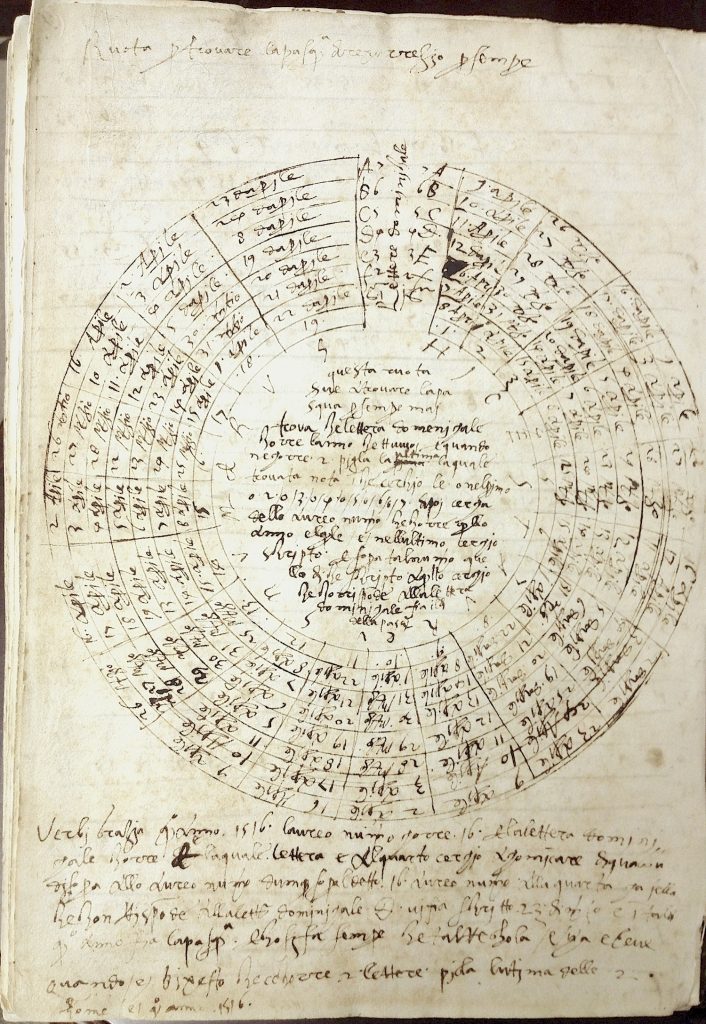While putting together materials for an instructional session for a cross-listed German and Religion course titled “Luther and the Bible: German Reformation Literature,” I stumbled across a number of discoveries in the Incunabula collection at Wilson Library. The course emphasized placing Reformation literature in its cultural context, so I wanted to make use of one of the collecting strengths of the Rare Book Collection to do so. Our holdings are particularly strong in incunabula, books printed by moveable type during the first 50 years of printing in the west. I found a large number of early editions of Jacobus de Voragine’s Legenda aurea (the Golden Legend) in our catalog in a variety of languages. The Golden Legend is a collection of hagiographies, or saints’ lives, first compiled around 1260. The Golden Legend was among the most widely read late medieval texts and went through several editions in the incunable period. In deciding what to show, I needed to pull a large number of these editions for a closer look.
While paging these volumes, I noticed a small volume on the shelf bound in printer’s waste. From the small amount of text visible on the spine I could tell it was German and likely fifteenth-century. I pulled the item off the shelf to read a bit more, and afterwards was relatively certain that this waste was from one of the hagiographies included in the Legenda aurea. I scanned the incunable range of the stacks and quickly found three other volumes bound with the same text. What made this particularly exciting (and rather coincidental) was that the professor of the course, Dr. Ruth von Bernuth, and I had spent several years working on identifying, dating, and describing a fragment of the Golden Legend in Middle High German that was preserved as the binding for this seventeenth-century book in the David M. Rubenstein Rare Book & Manuscript Library.

Jacobus de Voragine’s Legenda aurea was one of the most beloved and most disseminated texts during the medieval and early modern periods in Europe: by 1500 more than a thousand manuscript versions and about one hundred incunable versions existed. The text was extremely popular both in Latin and in the vernacular. In the German language alone there were about two hundred manuscript versions and forty early printings. The Rare Book Collection has three of these early German printings and none match the printer’s waste on the binding (Zainer, 1471-1472; Bämler, 1475; Schönsperger, 1496-1497).
The type does, however, look very similar to that of an early German Bible printed in 1483 by Anton Koberger. I found that Koberger had also printed a single edition of the Golden Legend in German in 1488. Both the Bayerische Staatsbibliothek in Munich and the Herzogin Anna Amalia library in Weimar had nicely digitized copies with indexes. I found the corresponding story in the digital copy and was able to confirm my suspicions: all four of the volumes were bound in printer’s waste from Anton Koberger’s 1488 German edition of the Golden Legend, making this the fourth incunable edition of the German translation of the Golden Legend held by the Rare Book Collection.

The printer’s waste contains fragments of three different stories of saints. There is a leaf from the story of Saint James, which details the miracle of an infertile woman who petitioned James for a child, became pregnant and gave birth to a son. There are two items bound with leaves from the same episode where Theophilus is sent to discover the body of Saint Anthony. The final waste leaf details episodes of the Virgin Mary’s miraculous interventions and help for those who prayed to her. Koberger uses the same beautiful type from his 1483 Bible in his edition of the Heiligenleben, a print fashioned after fifteenth-century hand, thin and graceful, yet surprisingly easy to read and incredibly recognizable. You can see the catalog record I created here.
Leaves of parchment and paper were often reused in the binding of early modern books. These leaves were typically taken from broken, discarded, or outdated manuscripts. Liturgical manuscripts were commonly used for binding as they were frequently replaced due to heavy use. The three German editions of the Golden Legend in the RBC’s Incunabula Collection are bound with leaves from a liturgical manuscript. Manuscript or paper waste was used as book covers, end leaves, spine linings, and more, sometimes invisible until a book is damaged.

The bindings created using leaves from Koberger’s Golden Legend may be evidence of the history of antiquarian book collecting. These four bindings date from the late 19th or early 20th century and have a shared provenance: the library of Reverend Aaron Burtis Hunter, clergyman, educator, and book collector. They were acquired by the Rare Book Collection in 1929 through the generous support of Hanes family. Because Koberger’s edition was heavily illustrated and often hand-colored, woodcuts were often removed and sold separately to collectors. All of the leaves used in these bindings do not contain woodcuts, but are close to leaves that did. It may be that rather than keep a heavily mutilated book, the leaves without illustrations were reused as waste for bindings.
In fact, the Incunabula Collection also holds thirteen volumes bound in printer’s waste from Anton Koberger’s 1483 German Bible (Ninth German Bible). This adds to the hundreds of volumes similarly bound in modern bindings worldwide. The RBC also holds a heavily mutilated copy of this Bible, but the leaves used to bind these volumes did not come from this particular piece as many are present despite the mutilations.



Much can be learned from binding waste: textual transmission, provenance, book history, textual history, popular culture, and more. These particular fragments testify to the enormous popularity of the text both in the vernacular and in Latin. The images and tales of the lives of the saints were deeply embedded in popular culture and these binding remnants are a visual reminder of this.



![Baldo Bartolini, De dotibus et dotatis mulieribus ([Venice] : Expensis [et] ingenio Paganini de Paganinis .... 9 March 1496) | Folio-2 Incunabula 354.5](https://blogs.lib.unc.edu/rbc/wp-content/uploads/sites/4/2015/09/Inc_354-5_FINAL_crop-957x1024.jpg)